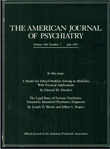Sex Differences in Blood-Oxygenation-Level-Dependent Functional MRI With Primary Visual Stimulation
Abstract
OBJECTIVE: The authors evaluated the effect of sex on data derived from activation studies using blood-oxygenation-level-dependent (BOLD) functional magnetic resonance imaging (MRI). METHOD: Gradient echo-echo planar imaging was used to measure BOLD signal response in the primary visual cortex in response to binocular photic stimulation in 16 healthy, young subjects (eight women and eight men). RESULTS: BOLD signal response was 38% lower in women than in men, and much of the difference was lateralized to the right hemisphere. CONCLUSIONS: Lower BOLD signal response in women may reflect a sex difference in the brain's response to a primary visual stimulation or in the physiology underlying BOLD functional MRI signal changes.



